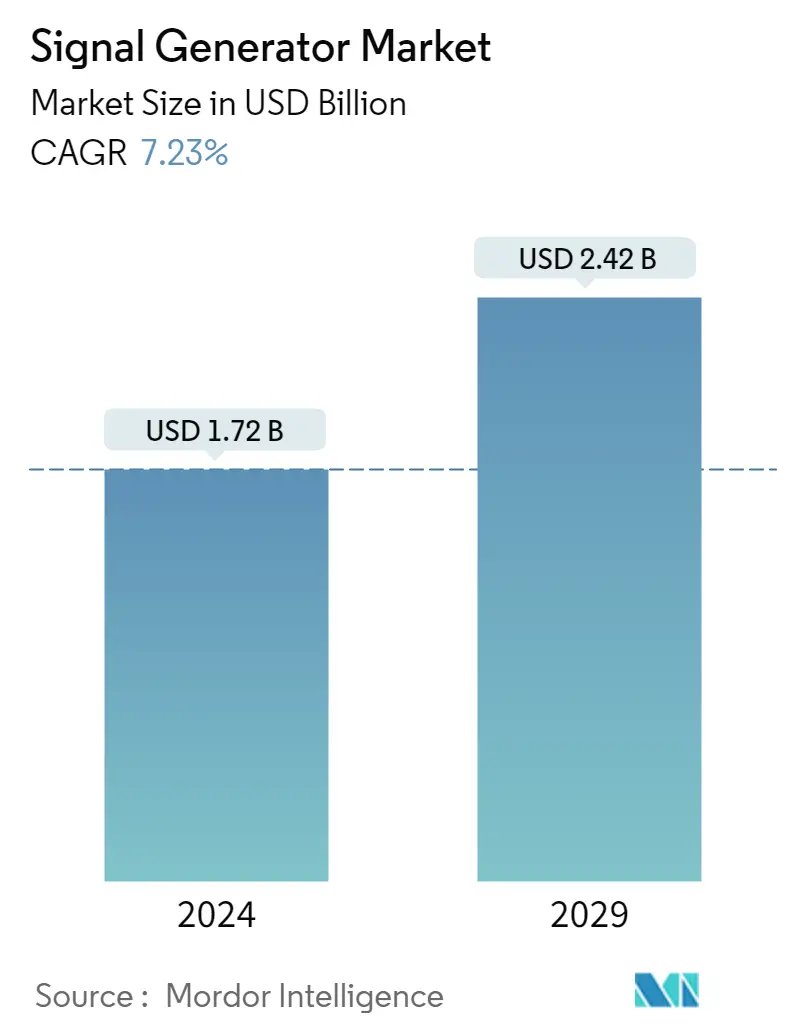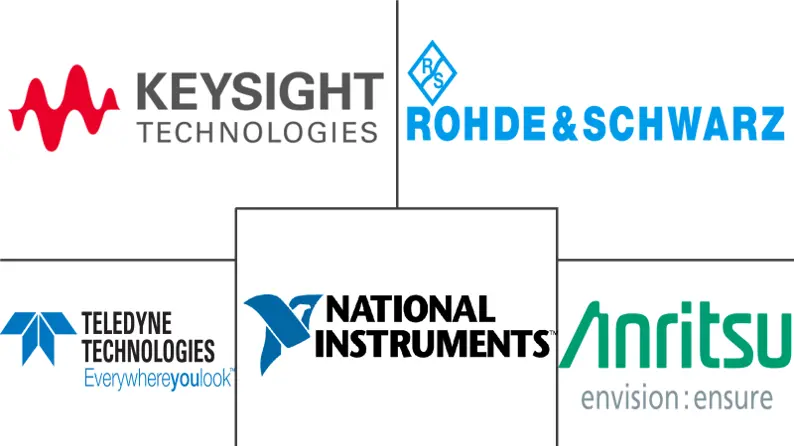Market Size of Signal Generator Industry

| Study Period | 2019 - 2029 |
| Market Size (2024) | USD 1.72 Billion |
| Market Size (2029) | USD 2.42 Billion |
| CAGR (2024 - 2029) | 7.23 % |
| Fastest Growing Market | Asia-Pacific |
| Largest Market | Asia-Pacific |
Major Players
*Disclaimer: Major Players sorted in no particular order |
Need a report that reflects how COVID-19 has impacted this market and its growth?
Signal Generator Market Analysis
The Signal Generator Market size is estimated at USD 1.72 billion in 2024, and is expected to reach USD 2.42 billion by 2029, growing at a CAGR of 7.23% during the forecast period (2024-2029).
Signal generators are also called frequency synthesizers and are crucial instruments of almost all RF/microwave test -and -measurement systems. They are extensively used to test, repair, and troubleshoot various electronic devices and systems. Further, they are expected to be the fastest-growing segment in the global test-measurement market over the next few years. Signal generators have evolved from simple continuous-wave devices to advanced modulation devices with superior software control, modulation capabilities, and user interfaces. Improvements such as using new software techniques that enhance the linearity, bandwidth, and signal creation capabilities further increase the market share for signal generators.
- It is expected that the demand will be driven by wireless communications, aerospace and defense, automotive industries, and new technologies such as 5G. 5G R&D and design activity primarily impact demand for RF Generators. Continued development of wireless standards is further expected to push the need for this equipment over the forecast period. The industry also demands more complex waveforms, ranging from traditional analog modulation to complex vector formats such as IQ modulation. A shift in market requirements toward higher operating frequencies and wider modulation bandwidths is expected due to new technologies such as 5G and the next generation of wireless cellular technology.
- The rapid development of standards such as wireless interoperability for microwave access (WiMAX), third-generation (3G) wireless, fourth-generation (4G) wireless, and wideband code-division multiple access (WCDMA) will aid in growth in the 5G domain. This would further increase the demand for signal generators. Testing is forecast to be the most widely used among all the applications. With the increased adoption of the Internet of Things (IoT), many devices are connected to the internet. While low latency is not provided for all applications and devices in the short term due to costs, the desire for low or no latency for several devices and applications exists and offers opportunities to test manufacturers, who then utilize signal generators.
- In February 2021, STI Vibration Monitoring Inc. launched its CMCP-TKSG field signal generator, a compact, portable device for vibration and displacement measurements. The CMCP-TKSG field signal generator is ideal for engineers and technicians who perform installation, maintenance, troubleshooting, and calibration verification on vibration monitoring systems. The battery-powered CMCP-TKSG simulates a fixed frequency acceleration, velocity or displacement signal, and DC voltages for gap/position monitors. The signal amplitude can be adjusted in 10 pre-defined increments or manually adjusted using the variable output setting.
- Companies are also involved in partnerships. For instance, in November 2021, Lockheed Martin, a security and aerospace company, and Keysight Technologies Inc. announced a partnership to advance 5G to check the response and security of signal generators to support mission-critical communications for aerospace and defense applications.
- Educating end users on interoperability and the need for specialized testing equipment is essential for market success. At present, the lack of end-user awareness of the need for proactive solutions limits the large-scale use of a signal generator. End-user inability to identify the appropriate answer from various identical systems limits adoption. The COVID-19 pandemic harmed the market, with customers' preferences moving toward essential items, dropping the demand for automobiles and electronics. The aerospace sector also witnessed a significant decline due to the closing of borders and the international travel ban. Thus, vendors supplying these industries reported a decline in revenue in the first quarter of 2020.
